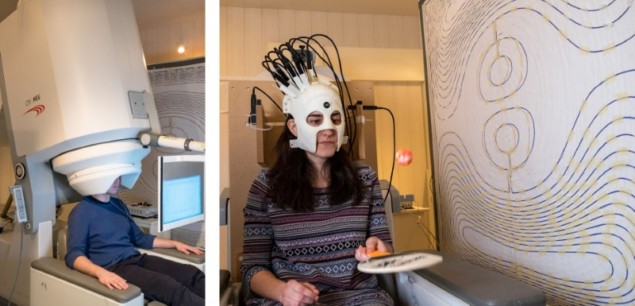
Magnetoencephalography (MEG) enables allows direct imaging of brain activity by measuring magnetic fields generated at the scalp by neural currents. MEG is currently performed using an array of cryogenically-cooled superconducting quantum interference devices (SQUIDs) placed in a one-size-fits-all helmet. Such systems, however, are cumbersome and highly sensitive to head motion – even a 5 mm movement can make the images unusable. As such, they rely on compliant adults who can remain still inside the scanner.
Now, a research team from the University of Nottingham and University College London has developed a wearable MEG system that can record brain activity at millisecond resolution while a subject is moving. The prototype headset opens up new possibilities for scanning any patient group, including infants or patients with movement disorders, and subjects who are free to move and interact with the real world (Nature doi: 10.1038/nature26147).
The system is based on an array of optically pumped magnetometers (OPMs) – magnetic field sensors that can record biomagnetic signals without needing cryogens. Each OPM sensor contains a glass cell containing 87Rb vapour, heated to about 150 °C. A 795-nm laser beam is used to spin-polarize the atoms, and the intensity of light transmitted through the cell is detected using a photodiode.
In zero magnetic field, the spin magnetic moments align with the beam, and transmission of laser light is maximized. However, the presence of a magnetic field perpendicular to the beam causes a measurable drop in light transmission. The sensors have a noise level comparable to that of a SQUID and a dynamic range of ±1.5 nT.
The researchers created a prototype system comprising an array of sensors mounted in a 3D-printed helmet designed using an anatomical MRI scan of the subject’s head. They note that, although the glass cells are heated, the sensors’ external surfaces remain close to body temperature and can thus be placed directly onto the scalp. The lightweight helmet contains 13 OPM sensors mounted on the scalp over the right sensorimotor cortex, and four reference sensors placed close to the head to measure background interference.
Although the wearable MEG system is housed inside a magnetically shielded room, it is still essential to cancel out the remnant Earth’s field. To do this, the team constructed a set of bi-planar electromagnetic coils that generate fields equal and opposite to the remnant Earth’s field. The coils – designed on two 1.6 m2 planes, placed either side of the subject – achieved a 15-fold reduction in the remnant field.
The researchers recorded OPM measurements with and without field nulling and saw that, without field nulling, the OPM sensors saturated during head movement. With field nulling, however, the OPMs could capture MEG data even while the head was moving.
High performance
To test the prototype OPM-MEG system, the researchers measured electrophysiological activity in a subject’s right sensorimotor cortex during visually cued finger motion. This task elicits a reduction in endogenous beta band oscillations during movement and a rebound when the movement stops. Such “beta modulation” is used as a marker of brain plasticity, psychosis and white matter degradation.
The experiment comprised 50 trials, of 1 s of finger abduction and 3 s of rest. Each subject performed the experiment 12 times: six during which they kept as still as possible, and six during which they made natural head movements, such as nodding, stretching, drinking tea and even playing ping pong.
OPM-MEG performed consistently across experiments, with the characteristic beta decrease and rebound clearly delineated and localized to the sensorimotor cortex. Despite head movement of more than ±10 cm, the team saw no significant difference in signal-to-interference ratio between the moving and static runs. Comparison with static experiments recorded using a cryogenic MEG system showed that the spatial resolution of the OPM system was better than that of the cryogenic system.
“This new technology raises exciting new opportunities for a new generation of functional brain imaging,” said Matthew Brookes, who leads the MEG work in Nottingham. “Being able to scan individuals whilst they move around offers new possibilities, for example to measure brain function during real world tasks, or genuine social interactions. This has significant potential for impact on our understanding of not only healthy brain function but also on a range of neurological, neurodegenerative and mental health conditions.”



